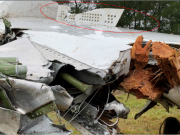
Evaluation of a pilot’s speech before a flight might prove to be an accurate means of determining whether he or she is dangerously sleepy or fatigued1 and should not fly an aircraft, according to a report by a team of Brazilian researchers.2
Aviation Research, Human Factors
How a pilot speaks may help identify cases of fatigue and sleepiness, researchers say.
by Linda Werfelman | April 19, 2019

Evaluation of a pilot’s speech before a flight might prove to be an accurate means of determining whether he or she is dangerously sleepy or fatigued1 and should not fly an aircraft, according to a report by a team of Brazilian researchers.2

accident investigation, Human Factors Issues, Accident/Incident Investigation, Human Factors, News
The A320 crashed during an attempted go-around that followed an engine-damaging gear-up touchdown.
by Mark Lacagnina

Aviation Research, fatigue, News
Smart watches and other new sleep-monitoring devices could be a boon to sleep management programs,…
by FSF Editorial Staff

Accident Investigation, Human Factors, News
The Falcon 20 descended rapidly into trees after the flight crew deployed the air brakes…
by Mark Lacagnina
